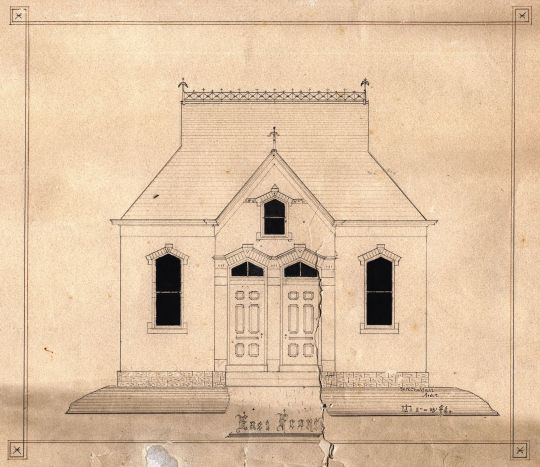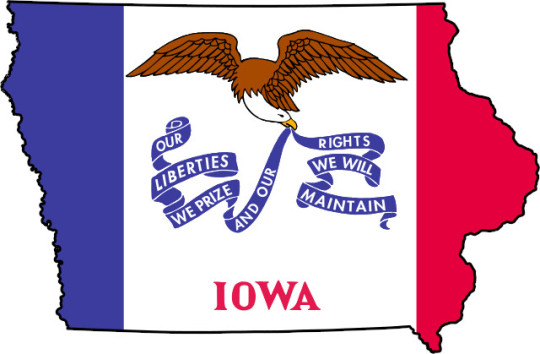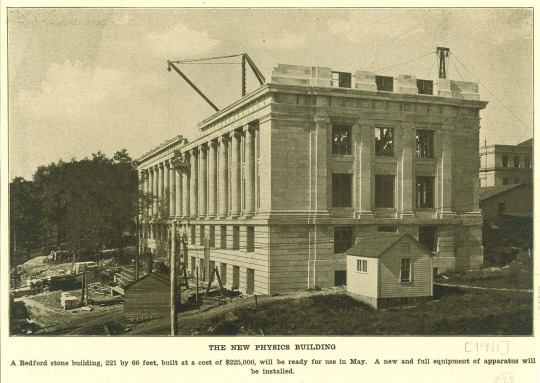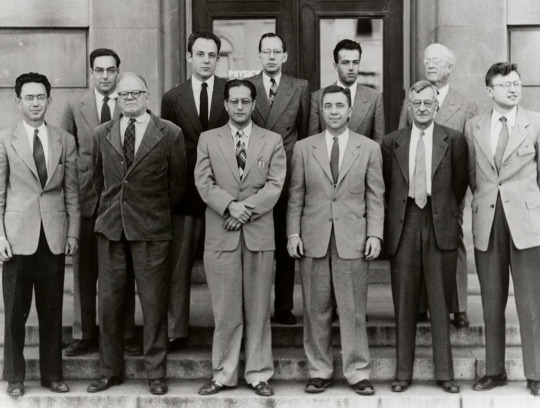Text
Old Brick and the Origins of the Historic Preservation Movement of Iowa City
Old Brick, formerly First Presbyterian Church. Photo by Tim Weitzel
Just north of the central business district of Iowa City stands a red church building known as Old Brick. It was built in the middle of the nineteenth century at the corner of Clinton and Market Streets and now sits adjacent to the present University of Iowa Campus. Old Brick was constructed in an eclectic Romanesque revival…

View On WordPress
0 notes
Text
Can a map be made of which Native nations lived in Iowa before Euro-American Settlement?
There's a new post that I wrote up on my blog. that addresses this.
https://timweitzel.wordpress.com/2023/12/11/problems-in-mapping-iowas-native-nations/

1 note
·
View note
Text
I O W A.
Why does the inscription on the Old Capitol read I O W A . ?
An Unconventional Convention: Using a full stop at the end of a building inscription.
The name IOWA. appears above the east and west entrances to the Old Capitol. Photo by Tim Weitzel.
Old Capitol was built to be the seat of government of the Territory of Iowa and was the first capitol of the State of Iowa. It is now a museum that is part of the University of Iowa Pentacrest Museums. The simple…

View On WordPress
#Architecture#Books#Iowa City#Iowa City History#iowa history#johnson county history#Letterpress#Printing#University History#University of Iowa
0 notes
Text
When Ingelheim am Rhein was in France
My High School French instructor, Mr. Bechtel, had a lot of stories for his class but one he told us more than once was the situation of school children in the disputed areas of France and Germany and how their primary language instruction would shift from German, to French, and back to German. This was especially the case in the area of Alsace, but it also applies, to a lesser degree, to the…

View On WordPress
4 notes
·
View notes
Text

A new blog post is up. It talks about the history of the name Iowa State University.
0 notes
Text

An aerial view taken in about 1906 by Samuel Calvin from the top of the tower on the First Presbyterian Church (Old Brick). St. Mary's Church is at the center, left of the image and the Congregational Church on the right. The Park House hotel and what was then the Medical Laboratory building can be seen in the center. Past those are the Homeopathic Hospital and the Chemistry-Pharmacy building where Van Allen Hall and Biology East stand today. From the Samuel Calvin Collection of Photographs, University of Iowa Libraries.
0 notes
Text

First Presbyterian Church between 1859 and 1877. Public domain image from wikimedia commons, image made by T. W. Townsend, reprocessed by Tim Weitzel
0 notes
Text
History and Architecture Quiz Answer
The answer is Old Brick.
Just north of the central part of Iowa City and located on the eastern edge of the University of Iowa campus stands a red brick church building we now call Old Brick. It is one of the oldest in Iowa City and is the oldest surviving church building. The building was listed on the National Register of Historic Places in 1973.
Old Brick was constructed in an eclectic Romanesque revival style between 1856 and 1865. Following the derecho of July of 1877, the tall steeple that was destroyed needed to be replaced. A square crenelated parapet was installed making the tower look like a castle from the Middle Ages of Europe. Various other details blend a sixteenth century church floor plan with revivalist themes from Norman Period and the High Middle Ages.
The building was constructed for the North Presbyterian Church. The congregation of this church organized in 1840 and was the first Presbyterian congregation in Iowa City, so their buildings were also known as First Presbyterian. The congregation also appears in histories as the “Old School” church. There is a lot to unpack there, and critical discussion of the schism that led to Old and New School Presbyterian churches is valid but will not take place here. It is enough to note that the schism in the North was resolved by 1869.
It’s not clear at this time what role the individuals that were members in the First Presbyterian Church played in the change in Iowa that occurred in the decades leading to the Civil War, but since the new church building was not completed until after the end of the Civil War it likely played no great part in events surrounding the war or its related movements such as Freedom seekers passing through Iowa City on the way to Chicago or Canada.
In the decades following the Civil War, the polymath Professor Samuel Calvin was a member of First Presbyterian church and he took some of the first aerial photographs of Iowa City from the top of the tower. But the building is more than a symbol of the Nineteenth Century. Old Brick is also the living record of the contemporary historic preservation moment in Iowa City.
A short version of the story of saving Old Brick goes as follows. By the late 1960s, the First Presbyterian Church had a new pastor and many members of the congregation wanted to move to a new building. Iowa City was undergoing urban renewal and demolition of old buildings was very common. The appeal of the suburbs probably was at its greatest since the major expansion of suburban styled subdivisions in Iowa City during the first decades of the twentieth century. The church decided to move to a new location on the edge of the built up area of town, offering to demolish the building to more easily find a buyer of the property.
In a series of events worthy of a novel or movie adaptation a story unfolded in the local, state, and, at one point, the national press. There were many players including multiple parts of the State government, sometimes working across purposes. University professors from two universities, the The University of Iowa administration, the Iowa Board of Regents, The Iowa Division of Historic Preservation, as well as members of two church congregations and other members of the Iowa City community organized in three different groups all played a role. For the promotional reel, pan in on two members of the church as they nail grievances to the door and then are later excommunicated for causing a disruption. The Iowa Division of Historic Preservation ultimately was a major broker of the final negotiation as were a group that included lawyers and concerned citizens who were vocal in the press and the courts. Again, there is much to tell here at another place or time.
Today, Old Brick is a good example of adaptive reuse of a historic building. Operated by the Episcopal Diocese of Iowa, the main hall, the former sanctuary, serves as an events space sought after by many. The former classrooms and offices serve as low cost rental space for nonprofit organizations.
Links for Old Brick and Friends of Historic Preservation
Old Brick website https://oldbrick.org/
Friends of Historic Preservation https://www.ic-fhp.org/about
Sources
Clarence Ray Aurner, Leading Events in Johnson County, Iowa History. Volume 1. Cedar Rapids, IA: Western Historical Press, 1912, pp. 311–322
Clarence Ray Aurner, Leading Events in Johnson County, Iowa History. Volume 2. Cedar Rapids, IA: Western Historical Press, 1913, pp. 366–367
Daily Iowan, Nov. 23, 1967, p. 1
Daily Iowan, Jan 1, 1974, p. 1
Iowa City’s Friends of Historic Preservation: Their First 25 Years. Iowa City: Friends of Historic Preservation, 2001.
Joseph Hubbard, Chair. The Presbyterian Church in Iowa, 1837–1900: History. Cedar Rapids: Committee of Synod of Iowa, 1907, p. 3
Mrs. Joseph E. [Tillie] Baker, North Presbyterian Church. National Register Nomination Form ID 73000730, Washington, D.C.: Keeper of the Register, National Park Service, 1973
This essay relates to the quiz questions posted on March 14, 2023 and was written by Tim Weitzel.
CC-BY-NC 4.0 or by standard written permission from the author.
0 notes
Text
Iowa City Building and History Trivia Quiz
This is an architectural history and history quiz. I am posting photos that I took of a building along with written clues with facts that either I am familiar with or are common knowledge. You can try to guess what the building is or just read through to enjoy some trivia about this building.

1. This Romanesque Revival building is in Iowa City, Iowa.
2. University of Iowa Professor Samuel Calvin took some of the earliest aerial photos of Iowa City from this building.

3. The building is one of the oldest of its type that survive in Iowa City.
4. The building was built for a literal Old School group.
5. The building was damaged in a derecho wind storm in 1877. The University of Iowa Professor Gustav Hinrichs was the first to name that type of storm and report data on it.
6. Although historic preservation activities took place took place in Iowa City before 1976, the grassroots organizing of a group to save this old building made of brick is considered by many to be the origins of the contemporary historic preservation movement in Iowa City.
The answer will be given in the next post along with a brief historical sketch.
0 notes
Text
The University Water Closet—A Modern Answer to An Urgent Need
The University Water Closet—A Modern Answer to An Urgent Need
Water Closet East Elevation by W.N. Chalfant.
I recently completed a blog post on the UI WC for the University of Iowa Pentacrest Museums.
We usually don’t sit around thinking about restrooms. Our public facilities are kept warm and lit. They are cleaned for us. So it may be of surprise to learn that the University of Iowa faculty spent many of the early days of the University seeking…

View On WordPress
1 note
·
View note
Text
Our Liberties We Prize
Our Liberties We Prize
A Historical Gazetteer of Places Named Liberty in Iowa
Iowa has a lot of place names that invoke the values of patriotism and freedom. Plymouth County, for instance, has its America Township. There is an Independence Township in Jasper County. Hamilton County has a Freedom Township. But among this type of place names, the most by far are named Liberty in some form or another.
This…

View On WordPress
1 note
·
View note
Text
Historic Preservation in Your Community
For Flash Back Friday, I've posted a blog titled, Historic Preservation 101
Introduction
It seems almost everyone has an opinion about historic preservation. Some people like it, some don’t, and many people are adamant about their feelings. However, many people in historic preservation and the general public are not professionals with training or experience. There are often misconceptions about what historic preservation is intended to do. Some of these mistaken views…
View On WordPress
0 notes
Text
Native Peoples of Iowa as seen in Native American Indian Land Cessions
Native Peoples of Iowa as seen in Native American Indian Land Cessions

The land that is the United States today was turned over to the US Government in a series of federal legal actions beginning in the 18th century and continuing into the 20th for Alaska and Hawaii. Some 368 treaties, laws, and executive orders totaling around 1.5 billion acres of land conveyed right of ownership from indigenous peoples to the federal government, and eventually to private hands.…
View On WordPress
0 notes
Photo

James Van Allen (1914-2006) was born in Mt. Pleasant Iowa and completed his graduate studies at the University of Iowa. Following work for the war effort he returned to Iowa to become chair of the Department of Physics, later Physics and Astronomy. His research on cosmic rays was ground breaking, but when his team discovered the radiation belts around the earth he became famous. That success led to a new building for the department, but getting there wasn't easy. This article tells that story.
https://timweitzel.wordpress.com/2019/09/10/university-space-van-allen-hall-as-an-example/
0 notes
Text
Thomas B. Wales, Jr. and The Brookbank Herd
For National Dairy Month, Here is the history of Thomas B. Wales, Jr. and The Brookbank Herd

For a period of 10 years, 1881 to 1891, Iowa City, Johnson County, Iowa, was home to one of the leaders of the Holstein breeders of the United States. Thomas Beale Wales, Jr. (1839–1922) was a dairy stock breeder who is associated with the history of the Holstein breed of cattle in the United States and inventor of the first recording system for tracking animal pedigree. Many of his notable…
View On WordPress
0 notes
Photo



The New Physics Building, now MacLean Hall.
Top, from the school calendar, State University of Iowa, John Gabbert Bowman, President (1911 – 1914)
Middle, Men walking past the Physics Building, the University of Iowa, 1913
Bottom, Physics Faculty around 1956 on steps of the Physics Building. James Van Allen third from the right, front row (from Van Allen Day CD)
Photographer: Frederick W. Kent
Speaking Buildings: The MacLean Hall Inscriptions
a series in five parts
MacLean Hall (1912), originally named the Physics Building, was designed as one of four planned and highly ordered buildings to flank the Old Capitol and along with designed landscape architectural lawns became the Pentacrest we see today. The seventh university president, Charles Schaefer, came up with the plan and broke ground on the first building. George MacLean, eighth president oversaw a good deal of the construction, seeing the completion of Schaeffer and Macbride Halls and seeing the beginning of construction of the Physics Building.
MacLean housed the well established Physics, Mathematics, and Astronomy departments as well serving at least as a point to connect a radio antenna for the fledgling electrical engineering program. The antenna ran from MacLean to the Old Capitol. At one point the fine arts program also was housed in the building. Although the Chemistry Department was once intimately connected with Physics in the Department of Natural Philosophy, the two programs had separated by the time MacLean was built.
Probably the most famous events associated with MacLean Hall involve the 1958 launch of Explorer I and other early United States spacecraft made at MacLean after the department was headed by James A. Van Allen, beginning in 1951. In 1955, President Eisenhower announced the U.S. would launch an unmanned spacecraft, largely due the work of an informal committee that Van Allen had organized. He oversaw the construction of a new research and education building for the newly combined departments of Physics and Astronomy, two additional accomplishments of of Van Allen; astronomy had been previously part of the Math department. A telescope dome once poked up from the roof of MacLean and a atom smasher was located below ground in the area east of the building as well. Telescope dome, particle accelerator and machine shop to build spacecraft and instruments were all larger at the new building. And outlying facilities near Hills and North Liberty were also constructed.
0 notes
Text

It's Will Shakes, but with idiots! Make a pledge and get a postcard! (and some great entertainment) bit.ly/idiottale #idiotale #Shakespeare
0 notes